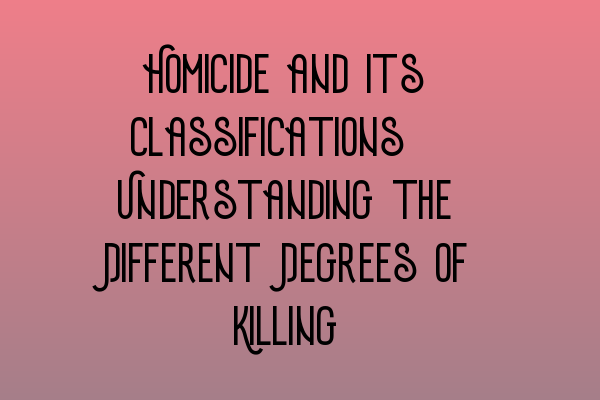Homicide and its Classifications: Understanding the Different Degrees of Killing
As criminal solicitors, it’s crucial to have a comprehensive understanding of homicide and its various classifications.
Homicide refers to the unlawful killing of a person, and it can be categorized into different degrees based on the
severity of the offense and the perpetrator’s state of mind.
Murder
Murder is the most serious form of homicide and involves the intentional killing of another person with malice
aforethought. This means that the perpetrator must have had the intent to cause death or grievous bodily harm to
the victim. The prosecution must prove beyond a reasonable doubt that the accused had the necessary intention and
was aware of the consequences of their actions.
In SQE1 Practice Exam Questions, you can find comprehensive practice questions related to murder and other criminal law
topics, which can help you strengthen your knowledge in this area.
Manslaughter
Manslaughter is a lesser offense than murder and is categorized into two main types: voluntary manslaughter and
involuntary manslaughter.
Voluntary Manslaughter
Voluntary manslaughter occurs when a person intentionally kills another person, but there are mitigating factors
that reduce the severity of the offense. These mitigating factors may include provocation, diminished
responsibility, or loss of control. The accused may not have had the necessary intent to commit murder due to
these factors.
Involuntary Manslaughter
Involuntary manslaughter, on the other hand, refers to unintentional killings that occur as a result of reckless or
negligent behavior. The accused may not have intended to cause harm, but their actions or omissions led to the
death of another person.
For further practice and understanding of manslaughter cases, you can explore the SQE 1 Practice Mocks FLK1 FLK2, which provide simulated cases and scenarios for better comprehension.
Culpable Homicide
Culpable homicide is a broad term that encompasses both murder and manslaughter. It refers to the act of causing
someone’s death, but the exact degree of culpability may vary depending on the circumstances and intent.
For SQE 2 Preparation Courses that cover specific aspects of culpable homicide and other criminal law topics,
consider enrolling in a comprehensive program to enhance your knowledge and skills.
Conclusion
Understanding the different degrees of killing, including murder, manslaughter, and culpable homicide, is crucial
for a criminal solicitor. The distinctions between these offenses and their associated legal requirements are
essential in building a strong defense strategy or prosecuting a case effectively.
For further information on SQE exam dates or preparation courses for SQE 1 and SQE 2, visit the relevant pages to ensure you stay up-to-date with your professional development.
Remember, continual learning and staying updated with legal developments are essential in delivering the best
legal services to clients and upholding justice.
Related Articles:
- SQE 1 Practice Exam
Questions - SQE 1 Practice Mocks FLK1
FLK2 - SQE 2 Preparation Courses
- SQE 1 Preparation
Courses - SRA SQE Exam Dates
